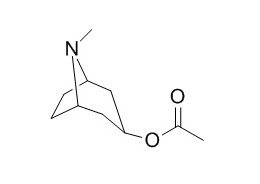3-Acetoxytropane
Reference standards.
Inquire / Order:
manager@chemfaces.com
Technical Inquiries:
service@chemfaces.com
Tel:
+86-27-84237783
Fax:
+86-27-84254680
Address:
1 Building, No. 83, CheCheng Rd., Wuhan Economic and Technological Development Zone, Wuhan, Hubei 430056, PRC
Providing storage is as stated on the product vial and the vial is kept tightly sealed, the product can be stored for up to
24 months(2-8C).
Wherever possible, you should prepare and use solutions on the same day. However, if you need to make up stock solutions in advance, we recommend that you store the solution as aliquots in tightly sealed vials at -20C. Generally, these will be useable for up to two weeks. Before use, and prior to opening the vial we recommend that you allow your product to equilibrate to room temperature for at least 1 hour.
Need more advice on solubility, usage and handling? Please email to: service@chemfaces.com
The packaging of the product may have turned upside down during transportation, resulting in the natural compounds adhering to the neck or cap of the vial. take the vial out of its packaging and gently shake to let the compounds fall to the bottom of the vial. for liquid products, centrifuge at 200-500 RPM to gather the liquid at the bottom of the vial. try to avoid loss or contamination during handling.
Plant Cell Physiol.2023, 64(7):716-728.
Front Pharmacol.2022, 13:906763.
Phytomedicine.2024, 155760.
Cells.2022, 11(8), 1311.
Biomol Ther (Seoul).2024, 32(5):546-555.
Aging (Albany NY).2021, 13(19):22867-22882.
Applied Food Research2024, 100662.
Mol Med Rep.2024, 29(2):26.
J of Essential Oil Research2019, 1677272
Int J Mol Sci.2019, 21(1):E265
Related and Featured Products
Planta medica, 1993,59(5):428-431.
Tropane alkaloid production in transformed root cultures of brugmansia Candida.[Reference:
WebLink]
METHODS AND RESULTS:
Transformed root cultures of BRUGMANSIA CANDIDA were established by infection with AGROBACTERIUM RHIZOGENES LBA 9402. Several clones with different growth index and tropane alkaloid pattern and content were obtained and two were examined in depth. The alkaloid content and pattern changed during the time course.
CONCLUSIONS:
At 21 days of culture clone 1 revealed an alkaloid spectrum dominated by 3alpha-acetoxytropane (3-Acetoxytropane, about 50% of the total alkaloid) and hyoscyamine (about 25%), with a ratio of hyoscyamine to scopolamine of 11.2. In clone 40 this ratio was 1.5 and the content of 3alpha-acetoxytropane was low (2%). The maximum concentrations of hyoscyamine were obtained at 3 weeks of culture, and were 700 and 500 microg/g FW in clone 1 and 40, respectively.



